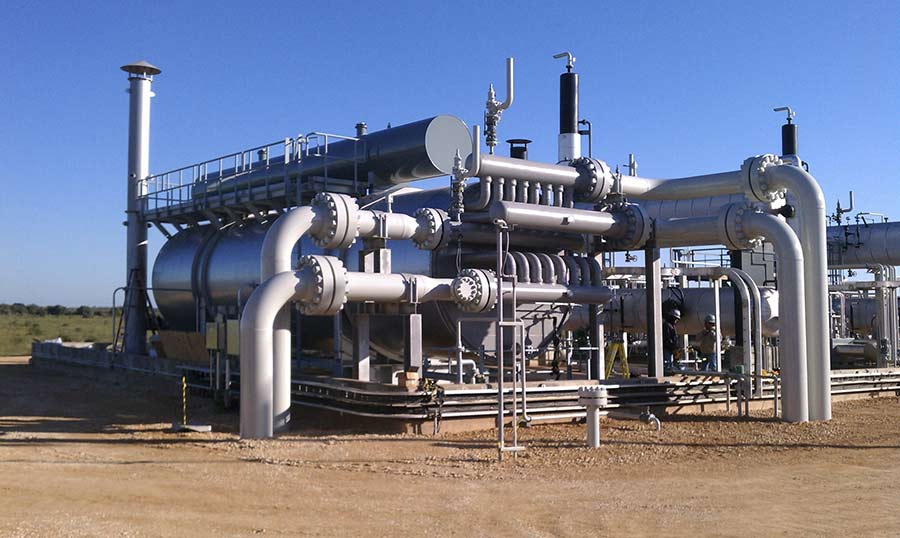Fuel Gas Conditioning for Combustion Turbines

The performance and durability of industrial or aeroderivative turbines hinge significantly on the quality of the liquid or gaseous fuel utilized. Poor-quality fuel can negatively impact the turbine's reliability, structural integrity, and compliance with environmental regulations. Therefore, ensuring fuel gas is adequately treated to eliminate impurities is crucial for any turbine or combustion turbine operation.
Understanding Fuel Gas Conditioning
Fuel gas conditioning involves filtering fuel to remove impurities and preparing it for use in combustion systems. Both liquid and gaseous fuels require conditioning to ensure all contaminants are eliminated. If left untreated, impurities in fuel can harm the system, leading to malfunctions, failures, or subpar performance.
Solid, liquid, and gaseous contaminants can be present in fuel gas, and they all affect the combustion system's performance. These contaminants enter the natural gas supply during mining, transportation, and production. Examples include:
- Calcium carbonate
- Debris from construction
- Gas hydrates and ice
- Glycols from dehydration processes
- Iron sulfate, iron, and copper sulfide
- Lubricating oils, wet scrubber oils, crude oil, and hydrocarbon liquids
- Rust
- Sand and clay
- Water and saltwater
With proper treatment, these contaminants can be removed from the fuel before it enters the combustion system. The initial fuel gas conditioning process removes solid and liquid impurities using an efficient coalescing filter. After removing the solids and liquids, the fuel gas is superheated using either fired or electric heating equipment. Superheating, or dew point heating, raises the gas temperature above the hydrocarbon dew point to prevent liquid hydrocarbons from forming in the fuel.
When Is Fuel Gas Conditioning Necessary?
Beyond contaminant removal, fuel gas conditioning ensures the fuel has the right chemical composition and consistency for use in gas turbines, often for both operational and warranty reasons.
Chemical Composition
Depending on the system, manufacturers might specify a Methane number or Lower Heating Value requirement for fuel used in their equipment. The fuel must be treated accordingly to meet these requirements. In some cases, a fuel gas source may be too rich, and heavy hydrocarbons must be removed to make the fuel compatible with the combustion system.
Moisture & Hydrocarbon Liquids
When fuel gas is transported from primary pipelines to the combustion turbine, the pressure reduction can lower the fuel's temperature below its hydrocarbon dew point. This temperature drop allows moisture and hydrocarbon liquids to accumulate, contaminating the fuel. Treating the fuel prior to injection into the system ensures optimal operation.
Risks of Improper Fuel Gas Conditioning
Introducing unconditioned or improperly conditioned fuel gas into a combustion unit poses several risks, including:
- System blockage
- Damage to the system or parts, such as oxidation, corrosion, or thermal erosion
- Increased emissions
- Combustor flameout
- Degradation of thermal barrier coatings
- Loss of seal segments
If not addressed, contaminated fuel can lead to decreased efficiency, unplanned outages, and violations of safety regulations. Moreover, identifying specific issues caused by poor-quality fuel becomes challenging once it has entered the gas turbine since the impacts will cascade throughout the system.
Signs of Fuel Gas Quality Issues
If you notice the following in your gas turbine(s), there may be gas quality problems:
- High exhaust temperature spread (T5 spread)
- Combustion instability
- Acoustic issues
- Combustor flameouts
- Emission output increases
- Unusual power outputs
- Visible signs of oxidation, erosion, and abnormal wear in hot end components
- Yellow sulfur deposits on control elements
- Loss of valve control
- Freezing or seizure of pressure regulators
Fuel Gas Conditioning from Sigma Thermal
Proper fuel gas conditioning is essential for maintaining the performance and longevity of turbine combustion systems. Using high-quality heating equipment ensures fuel is appropriately conditioned. For assistance selecting a fuel gas conditioning solution tailored to your needs, contact the experts at Sigma Thermal.
Â
Ultrasonic Welding Machine,Ultrasonic Welder,Sonic Welder,Handheld Ultrasonic Welder
Changzhou Piling Automation Technology Co., Ltd. , https://www.plultrasonicmould.com
